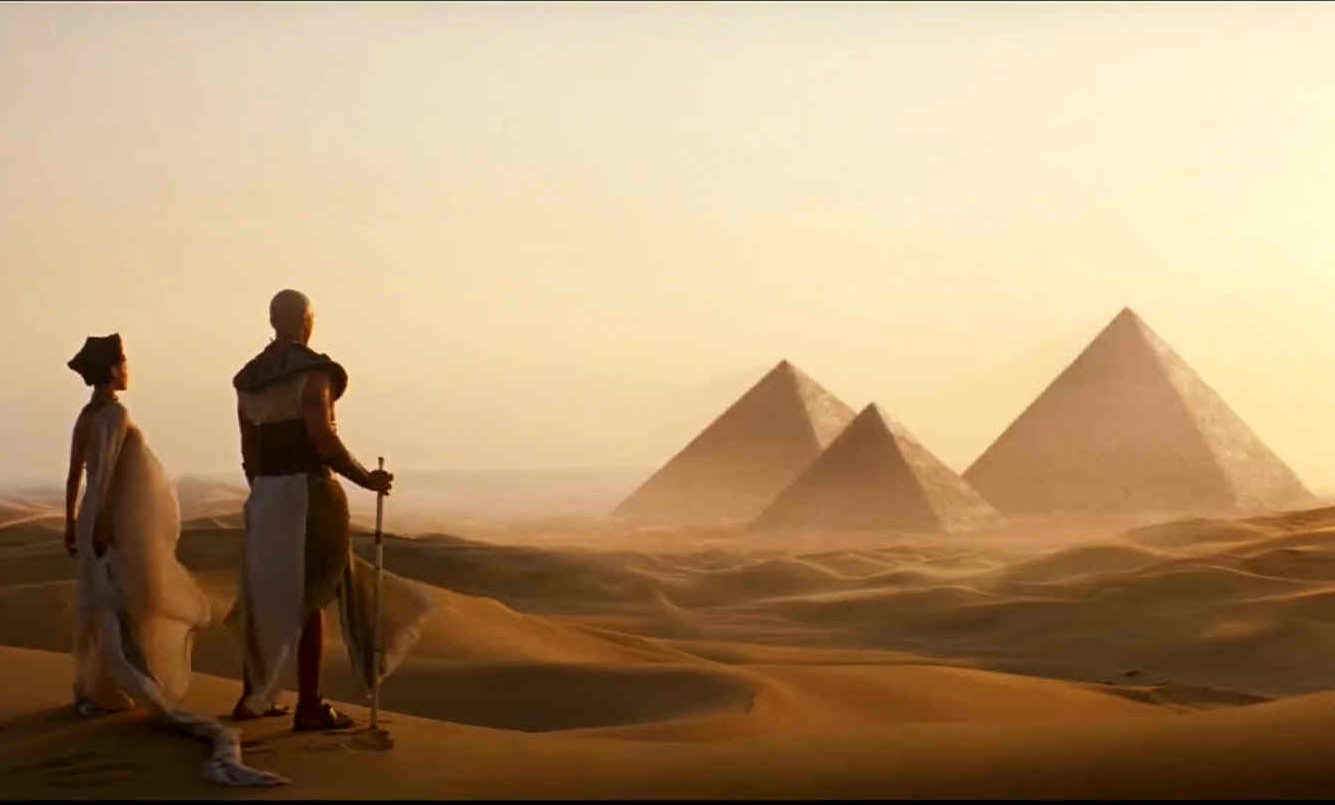
The
Sun God Ra - Tomb of Ramses IV
The ancient Egyptians revered Ra as the god who created everything. Also known as the Sun God, Ra was a powerful deity and a central god of the Egyptian pantheon. The ancient Egyptians worshiped Ra more than any other god and pharaohs often connected themselves with Ra in their efforts to be seen as the earthly embodiment of the Sun God.
He is also known as Re and Atum. His children are Shu, the God of Dry Air and Father of the Sky, and his twin sister Tefnut, the Goddess of Moisture and Wetness. As a lion-headed goddess, Tefnut is responsible for dew and freshness. Humans were created from Ra’s tears.
By the Fifth Dynasty, in the 25th and 24th centuries BC, he had become one of the most important gods in ancient Egyptian religion, identified primarily with the noon-day sun. Ra was believed to rule in all parts of the created world: the sky, the Earth, and the underworld. He was the god of the sun, order, kings and the sky.
Ra was portrayed as a falcon and shared characteristics with the sky-god Horus. At times the two deities were merged as Ra-Horakhty, "Ra, who is Horus of the Two Horizons". In the New Kingdom, when the god Amun rose to prominence he was fused with Ra as Amun-Ra.
The cult of the Mnevis bull, an embodiment of Ra, had its center in Heliopolis and there was a formal burial ground for the sacrificed bulls north of the city.
All forms of life were believed to have been created by Ra. In some accounts,
humans were created from Ra's tears and sweat, hence the Egyptians call themselves the "Cattle of Ra". In the myth of the Celestial Cow, it is recounted how mankind plotted against Ra and how he sent his eye as the goddess Sekhmet to punish them.
The ancient Egyptians believed that as the sun god, Ra’s role was to sail across the heavens during the day in his boat called the “Barque of Millions of Years.” In the morning when Ra emerged from the east, his boat was named, “Madjet” which meant “becoming strong.” By the end of the day the boat was called, “Semektet” which meant “becoming weak.” At the end of the day, it was believed that Ra died (swallowed by Nut) and sailed on to the underworld, leaving the moon in his place to light up the world. Ra was reborn at dawn the very next day. During his journey across the heavens during the day, he fought with his main enemy, an evil serpent named Apep, or also, The Lord of Chaos. In some stories, Ra, in the form of a cat named Mau, defeats the evil serpent, Apep. This is part of the reason why cats are so highly-revered in Egypt.
Ra was revered as the chief-god of the pantheon of Heliopolis and the creator of everything that existed. Ancient Egyptians believed that they owed their existence to god as he created the world and Ra was the king since this day. The pharaoh, or the king, was seen as his descendant or successor. The myth goes that Ra brought order in the world of chaos and the pharaohs were meant to do the same when they came on the throne. Since 25th century BC, when Ra gained in prominence, the pharaohs often connected themselves with Ra to establish their supremacy as they wanted to be perceived as the earthly embodiment of the almighty Ra.
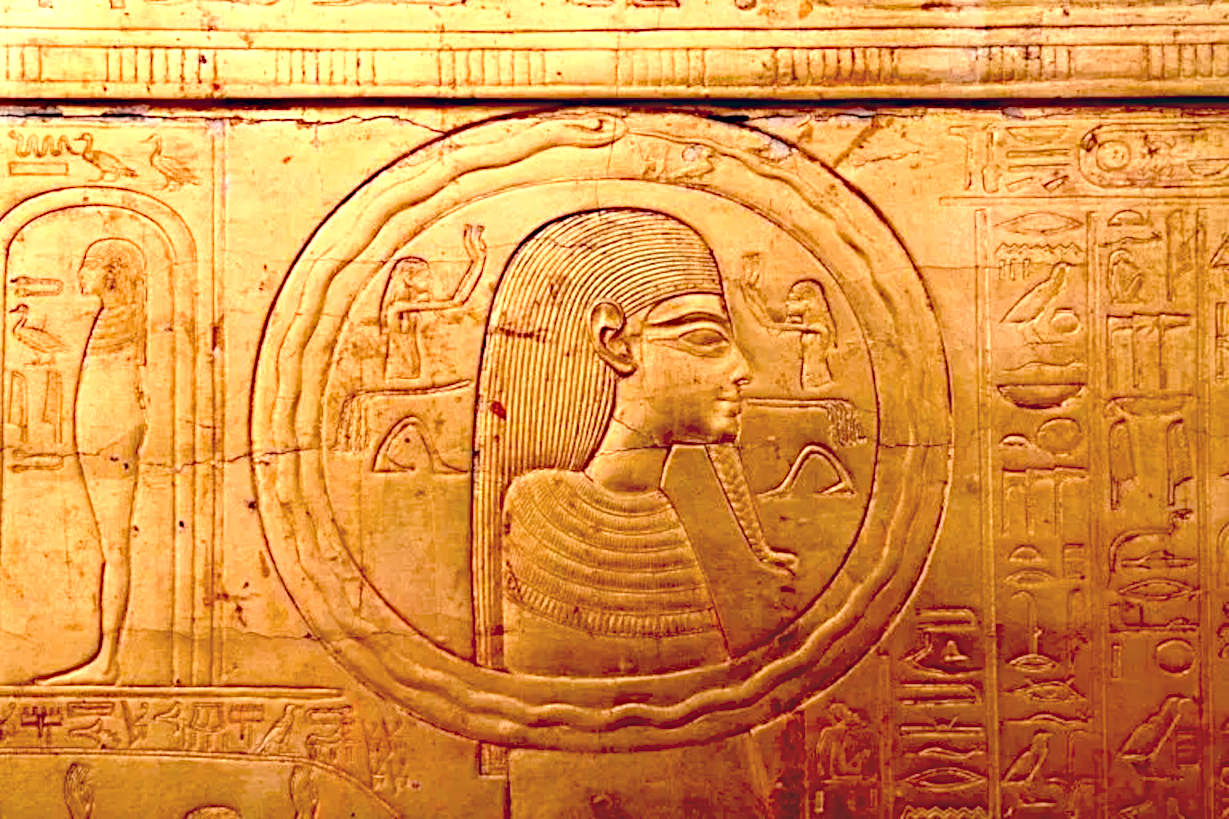
RELIGIOUS ROLES
The sun is the giver of life, controlling the ripening of crops which were worked by man. Because of the life-giving qualities of the sun the Egyptians worshiped the sun as a god. The creator of the universe and the giver of life, the sun or Ra represented life, warmth and growth. Since the people regarded Ra as a principal god, creator of the universe and the source of life, he had a strong influence on them, which led to him being one of the most worshiped of all the Egyptian gods and even considered King of the Gods. At an early period in Egyptian history his influence spread throughout the whole country, bringing multiple representations in form and in name. The most common form combinations are with Atum (his human form), Khepri (the scarab beetle) and Horus (the falcon). The form in which he usually appears is that of a man with a falcon's head, which is due to his combination with Horus, another sky-god. On top of his head sits a
solar disc with a cobra, which in many myths represents the eye of Ra.
At the beginning of time, when there was nothing but chaos, the sun-god existed alone in the watery mass of Nun which filled the universe. "I am Atum when he was alone in Nun, I am Ra when he dawned, when he began to rule that which he had made." This passage talks about how Atum created everything in human form out of the chaos and how Ra then began to rule over the Earth where humans and divine beings coexisted. He created Shu, god of air, and the goddess of moisture, Tefnut. The siblings symbolized two universal principles of humans: life and right (justice). Ra was believed to have created all forms of life by calling them into existence by uttering their secret names. In some accounts humans were created from Ra's tears and sweat.
According to one myth the first portion of Earth came into being when the sun god summoned it out of the watery mass of Nun. In the myth of the Celestial Cow (the sky was thought of as a huge cow, the goddess Meht-urt) it is recounted how mankind plotted against Ra and how he sent his eye, as the goddess Sekhmet, to punish them. Extensions of Ra's power were often shown as the Eye of Ra, which were the female versions of the sun-god. Ra had three daughters Bastet, Sekhmet and Hathor, who were all considered the Eye of Ra, who would seek out his vengeance. Sekhmet was the Eye of Ra and was created by the fire in Ra's eye. She was violent and sent to slaughter the people who betrayed Ra, but when calm she became the more kind and forgiving goddess Hathor. Sekhmet was the powerful warrior and protector while Bastet, who was depicted as a cat, was shown as gentle and nurturing.
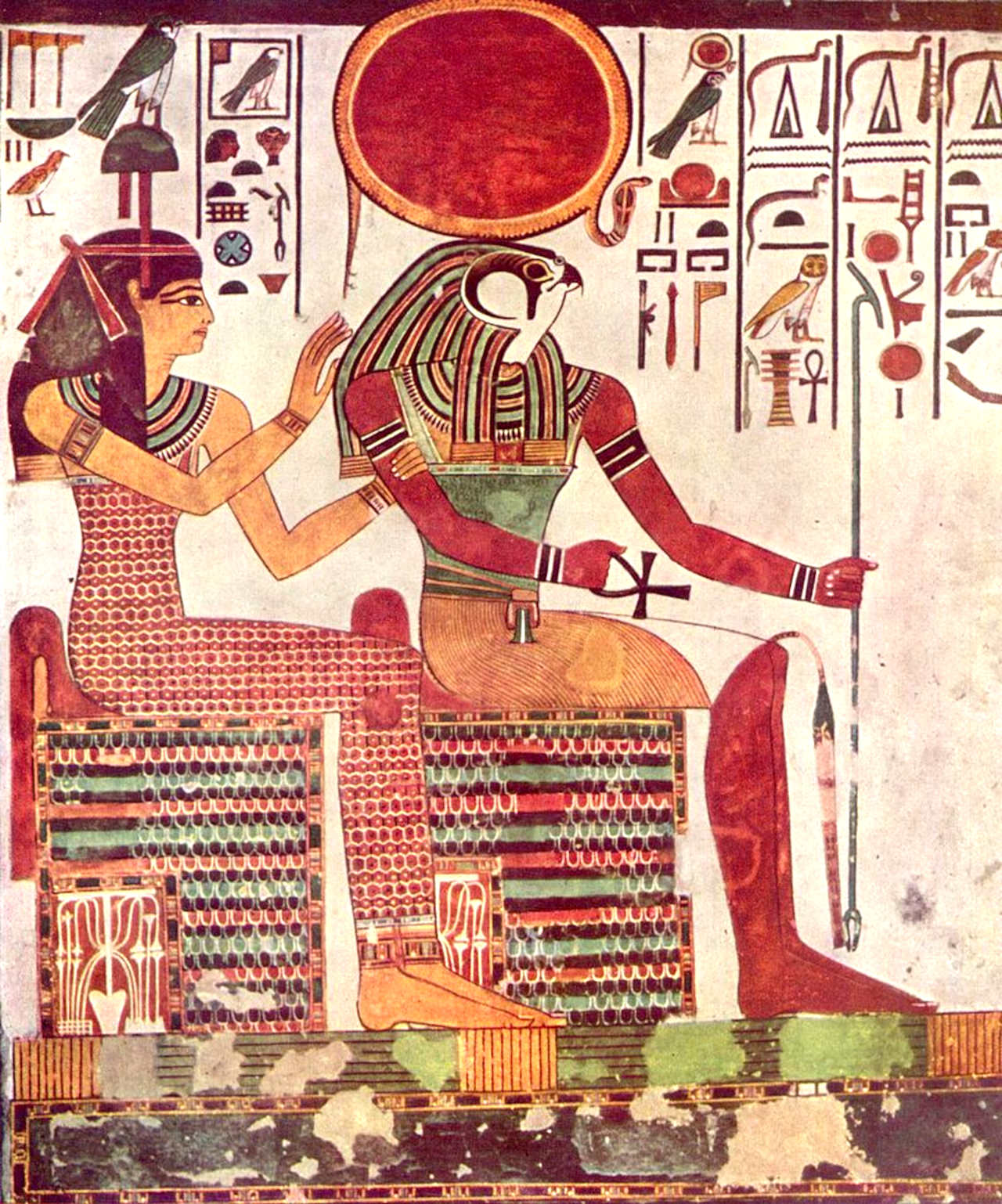
THE UNDERWORLD
Ra was thought to travel on the Atet, two solar barques called the Mandjet (the Boat of Millions of Years) or morning-boat and the Mesektet or evening-boat. These boats took him on his journey through the sky and the Duat – twelve hours of night which is also the literal underworld of Egypt. While Ra was on the Mesektet, he was in his ram-headed form. When Ra traveled in his
sun-boat, he was accompanied by various other deities including Sia (perception) and Hu (command), as well as Heka (magic power). Sometimes, members of the Ennead helped him on his journey, including Set, who overcame the serpent Apophis, and Mehen, who defended against the monsters of the underworld. When Ra was in the underworld, he would visit all of his various forms.
Apophis, the god of chaos (isfet), was an enormous serpent who attempted to stop the sun-boat's journey every night by consuming it or by stopping it in its tracks with a hypnotic stare. During the evening, the Egyptians believed that Ra set as Atum or in the form of a ram. The night boat would carry him through the underworld and back towards the east in preparation for his rebirth. These myths of Ra represented the sun rising as the rebirth of the sun by the sky-goddess Nut; thus attributing the concept of rebirth and renewal to Ra and strengthening his role as a creator god as well.
When Ra was in the underworld, he merged with Osiris, the god of the dead.
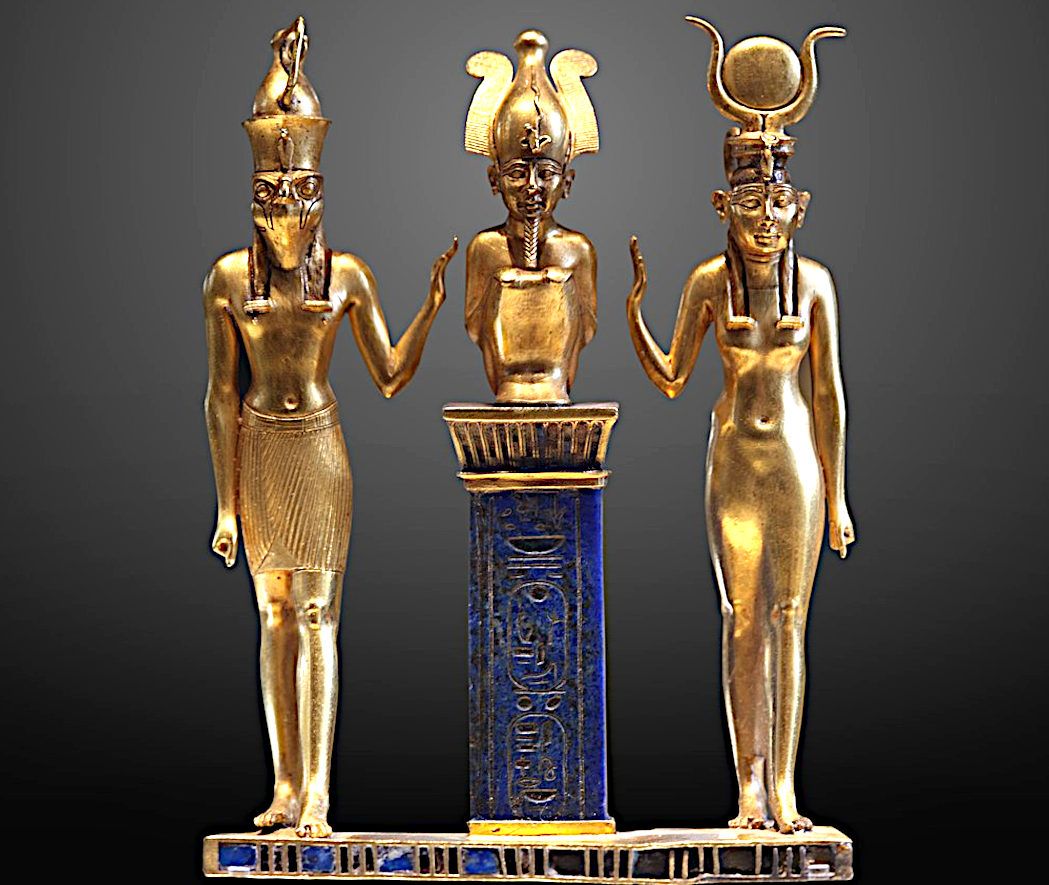
TEN INTERESTING FACTS ABOUT RA
1. TRANSFORMATIVE POWERS
The merging of Ra and Osiris in the Underworld later became the underlying philosophy of alchemy, and finally, Jung’s view on the cycle of transformation, known in alchemy as the ouroboros. The first appearance of the ouroboros is found in the funerary texts in the tomb of Tutankhamun. It represented the unified Ra-Osiris or the cycle of death and resurrection.
Simply put, alchemy is the art form of liberating something from its fixed physical properties. It is representative of what you would do in your own life if you are trying to transform yourself from your ordinary fixed physical self into your exalted state, an enlightened being. Carl Jung understood this well when he explained how death is the reason we are alive.
Alchemical work with the prima materia, known as the Great Work or Magnum opus, was later on recognized as the individuation process. But the four stages of alchemical transmutation can already be seen in the myth of Ra’s sailing on his solar barge. Nigredo phase is the night when Ra is swallowed by the underworld, while albedo, citrinitas, and rubedo represent the morning, midday and evening sun. This symbolism of growth, decline, death, and transformation appears in the Egyptian mortuary texts and bears the same message as the Jungian individuation process, in order to be truly alive. This goes as well for anything that is living, our culture, cultural systems, values – they all go through this same cycle of prosperity, decline, decay, and finally change.
We need to die in order to transform, shed our worn-out skin through our struggle with darkness and chaos. Only then can we be truly reborn, just as Ra is every morning. It is, essentially, an endless return to ourselves.
2. RA & OSIRIS
When Ra was in the underworld, he merged with Osiris, the god of the dead. This makes Set his own shadow, but in the realm of death and darkness, it is his shadow that can help him survive and be reborn.
Horus being the one to revive his father, Osiris is thus represented similarly to Ra, with a head of a falcon. This is why the Eye of Ra is very similar to the Eye of Horus.
3. RA & APEP
The sunset meant that Ra’s bark had been swallowed by Nut, and continued sailing to the underworld. His nemesis, the snake-like god Apep was thought to live there, sometimes considered the Eater of Souls. He awaited Ra in an attempt to plunge the world into Darkness. As a result, Ra enlisted the help of numerous defenders that will make their journey with him, one of whom was the god Set, the only one able to resist the hypnosis of the serpent.
4. THE MANY FACES OF RA
Ra himself went through a transformation cycle, just as he transformed throughout history and mythological genealogy. He had three incarnations – just as the Sun was different in the morning, midday and the afternoon. These symbolically represented the stages of prosperity, but what’s more interesting is his death and descent into the underworld.
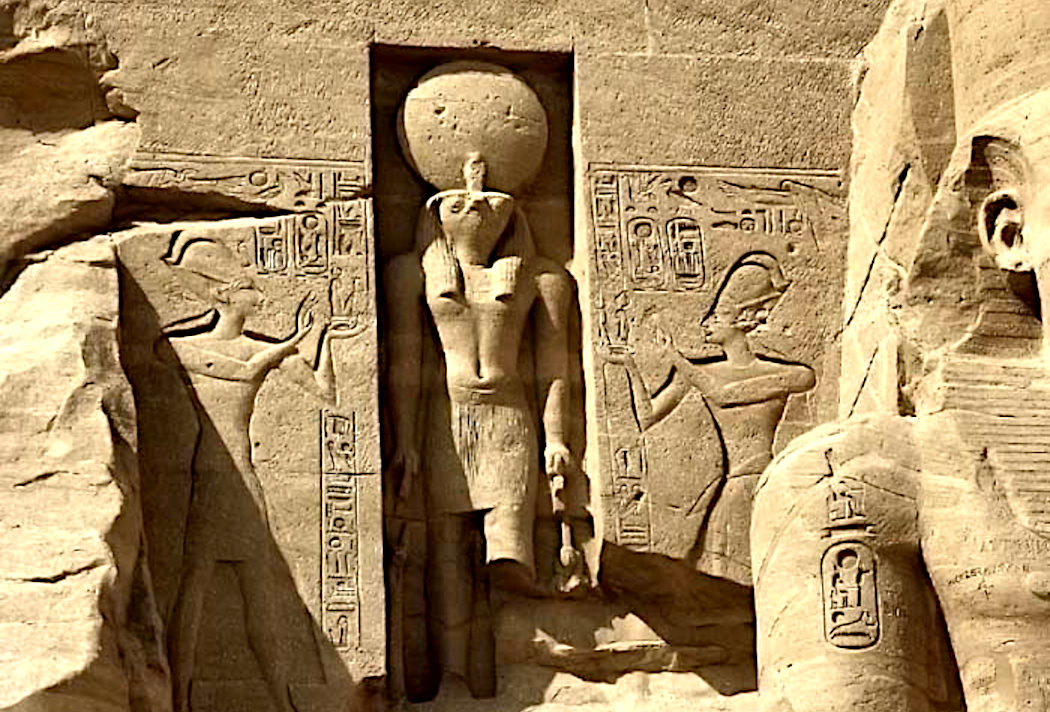
5. ANKH AS
SYMBOLIC OF LIFE
This intersection of the river Nile and the Sun is actually depicted in the hieroglyphic symbol of Ankh, with the irregular loop on top of the cross representing the delta of the river. In Egyptian writing and art, this symbol used to signify life itself.
Thus the god Ra was generally depicted holding an Ankh in his right hand. Many of the later gods were represented with an Ankh as well, which is indicative of the way in which ancient Egyptians perceived other gods as being some form or derivative of Ra.
But this also indicates another important aspect of abundant life. It requires transformation. There is no state of perfect, unchanging being. In order to be alive, we must go through change and death. We’ll see later on how this makes great sense symbolically, but first, let’s how the Egyptians envisioned this transformation through the many faces of Ra.
6. THE GOD OF CREATION
From the points of view of philosophy and history, the Egyptians conceived the world as the valley in which they lived. Apart from the primordial waters, the world also originated out of another dominant element, that is the sun. It is as cruel and merciless as it is nurturing, both giving life to all living beings and scourging lands and withering the crops. Its power was almost absolute at the time.
The earliest inhabitants of the land of Egypt saw the sun in the sky rise and set, as the waters of the Nile flowed from the south to the north, from the east to the west on a path that intersected that of the river itself. The sun was being swallowed every evening just as the god Ra was swallowed upon entering the Underworld. His rebirth was associated with the Sun showing up again on the horizon the next day.
Out of this simple observation, a deep mythological significance was derived. Firstly, being a solar deity, he is thus a manifestation of the creative life force embodied in the sunshine, fertile ground, and crops.
7. SUPREME POWER IN THE COSMIC UNIVERSE
By 25th century BC, Ra became one of the most important deities in ancient Egypt. He was believed to rule all parts of the world: the sky, the earth and the underworld. He was thus the supreme power in the cosmic universe. His importance can be understood by several myths regarding him. One myth believed him to be the ruler of all Gods while according to another, he was the only God and all other deities were nothing more than mere aspects of him. During the New Kingdom of ancient Egypt (16th century BC to 11th century BC), the worship of Ra gained even more significance and this is proved by depictions of the God on the tombs from this era.

FIGUREHEAD
- The Elizabeth Swann's figurehead is a combination of woman, bird and
fishtail, with wings like the ears of Anubis. Symbolizing the solar wings
that propel the ship via fins in the water. Cleopatra takes a shine to this
statue of the gods.
8. RA IS PORTRAYED AS A MAN WITH THE HEAD OF A FALCON
Ra was represented in a variety of forms. His most common portrayal was of a man with the head of a falcon, crowned with a shiny sun disc. This sun disc is encircled by a sacred cobra called Uraeus. In some other depictions, Ra is also shown as a man with the head of a beetle or a ram. The sun disk, Ra’s symbol, remains constant in all these illustrations. Among other things, Ra was also pictured as a full-bodied ram, beetle, phoenix, heron, serpent, bull, cat or lion. Some myths about Ra mention that Ra amalgamated himself in other forms such as Khepri or a beetle in the morning, Horakthty or solar disc in the noon and as Khnum or Atum (ram headed man) during sunset. At different times of the day, Ra changed from form to another but he continued to symbolize the sun throughout.
9. THE GODDESS ISIS IS ABLE TO STEAL RA'S POWERS
While Ra had incredible power, there is a myth that suggests that he ended up becoming weak later. The story goes that Ra drooled saliva as he grew old. Isis; the goddess of marriage, fertility, magic and medicine; knew very well that Ra’s powers lay hidden in his secret name. She wanted to know this secret name in order to become all-powerful herself. Isis collected Ra’s saliva, mixed it with clay and made a serpent with the purpose of biting Ra. Her plan was successful. Ra was in tremendous pain after the serpent bite and he summoned other gods to help him. Isis promised to heal Ra if he let out his secret name. Since the pain was intolerable, Ra allowed Isis to search through him. Thus Ra’s powers got transferred to Isis. Though she kept her promise of healing Ra, she forcibly abdicated him and made Horus the king of the gods.
10. THE FIRST TEMPLE DEDICATED TO RA WAS BUILT AT ABUSIR BY PHARAOH USERKAF
From the Fifth Dynasty or 25th century BC, Ra came to be closely associated with the pharaoh. The pharaoh of ancient Egypt since the fifth dynasty and thereafter came to be known as The Son of Ra and he even incorporated the name Ra to his name. Also, after the Fifth Dynasty, Ra became a state deity and pharaohs had specially aligned pyramids, obelisks and sun temples built in his honor. However, none of the solar temples built contained any statue of Ra. Instead, they were built with an open structure to receive sunlight, which symbolized the sun god. The first temple dedicated to Ra was built at Abusir by Pharaoh Userkaf, founder of the Fifth Dynasty.
|






